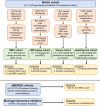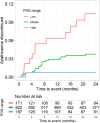Clinical associations with a polygenic predisposition to benign lower white blood cell counts
- PMID: 38649760
- PMCID: PMC11035609
- DOI: 10.1038/s41467-024-47804-5
Clinical associations with a polygenic predisposition to benign lower white blood cell counts
Abstract
Polygenic variation unrelated to disease contributes to interindividual variation in baseline white blood cell (WBC) counts, but its clinical significance is uncharacterized. We investigated the clinical consequences of a genetic predisposition toward lower WBC counts among 89,559 biobank participants from tertiary care centers using a polygenic score for WBC count (PGSWBC) comprising single nucleotide polymorphisms not associated with disease. A predisposition to lower WBC counts was associated with a decreased risk of identifying pathology on a bone marrow biopsy performed for a low WBC count (odds-ratio = 0.55 per standard deviation increase in PGSWBC [95%CI, 0.30-0.94], p = 0.04), an increased risk of leukopenia (a low WBC count) when treated with a chemotherapeutic (n = 1724, hazard ratio [HR] = 0.78 [0.69-0.88], p = 4.0 × 10-5) or immunosuppressant (n = 354, HR = 0.61 [0.38-0.99], p = 0.04). A predisposition to benign lower WBC counts was associated with an increased risk of discontinuing azathioprine treatment (n = 1,466, HR = 0.62 [0.44-0.87], p = 0.006). Collectively, these findings suggest that there are genetically predisposed individuals who are susceptible to escalations or alterations in clinical care that may be harmful or of little benefit.
© 2024. The Author(s).
Conflict of interest statement
S.C.B. has served on the scientific advisory board for Ipsen Pharmaceuticals and Fennec Pharmaceuticals. The remaining authors declare no competing interests.
Figures





Update of
-
Clinical consequences of a polygenic predisposition to benign lower white blood cell counts: Consequences of benign WBC count genetics.medRxiv [Preprint]. 2023 Aug 21:2023.08.20.23294331. doi: 10.1101/2023.08.20.23294331. medRxiv. 2023. Update in: Nat Commun. 2024 Apr 22;15(1):3384. doi: 10.1038/s41467-024-47804-5. PMID: 37662324 Free PMC article. Updated. Preprint.
References
-
- Higgins, V., Nieuwesteeg, M. & Adeli, K. Chapter 3 - Reference intervals: theory and practice. In Contemporary Practice in Clinical Chemistry 4th edn (eds Clarke, W. & Marzinke, M. A.) 37–56 (Academic Press, 2020).
Publication types
MeSH terms
Substances
Grants and funding
- U01 HG006385/HG/NHGRI NIH HHS/United States
- UL1 TR000445/TR/NCATS NIH HHS/United States
- K08 AR082454/AR/NIAMS NIH HHS/United States
- S10 RR025141/RR/NCRR NIH HHS/United States
- U01 HG004424/HG/NHGRI NIH HHS/United States
- U01 HG006389/HG/NHGRI NIH HHS/United States
- U01 HG006828/HG/NHGRI NIH HHS/United States
- U01 HG006380/HG/NHGRI NIH HHS/United States
- RC2 GM092618/GM/NIGMS NIH HHS/United States
- P50 GM115305/GM/NIGMS NIH HHS/United States
- U01 HG006379/HG/NHGRI NIH HHS/United States
- U01 HG011181/HG/NHGRI NIH HHS/United States
- R35 GM131770/GM/NIGMS NIH HHS/United States
- R01 GM130791/GM/NIGMS NIH HHS/United States
- U01 HG006830/HG/NHGRI NIH HHS/United States
- U01 HG006375/HG/NHGRI NIH HHS/United States
- U01 HG004438/HG/NHGRI NIH HHS/United States
- U01 HG006382/HG/NHGRI NIH HHS/United States
- U19 HL065962/HL/NHLBI NIH HHS/United States
- R01 GM126535/GM/NIGMS NIH HHS/United States
- R01 HD074711/HD/NICHD NIH HHS/United States
- U01 HG006388/HG/NHGRI NIH HHS/United States
- U01 HG006378/HG/NHGRI NIH HHS/United States
- UL1 RR024975/RR/NCRR NIH HHS/United States
- R01 NS032830/NS/NINDS NIH HHS/United States
- U01 HG004798/HG/NHGRI NIH HHS/United States
- UL1 TR002243/TR/NCATS NIH HHS/United States
LinkOut - more resources
Full Text Sources

